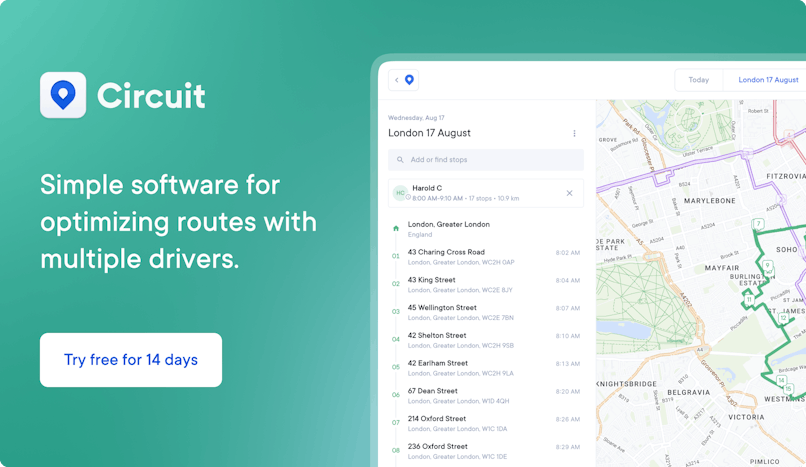What Is Assortment Planning? Retail and eCommerce Uses
Effective assortment planning can maximize sales for your retail or eCommerce business. Here are the best assortment planning strategies.

Optimize your retail and eCommerce assortment planning with Circuit for Teams, the all-in-one solution designed to save time, reduce costs, and drive business growth.
Assortment planning is a strategic retail business or an eCommerce approach to selecting the right mix of products to offer. It’s based on factors like customer preferences, market trends, and inventory management.
Stores can intuitively stock their shelves with a variety of products to offer something for everyone. But as the marketplace grows and customer preferences shift, things get a little more complicated.
That’s why you need an assortment planning strategy!
Assortment planning is part of the supply chain, helping you offer the right products at the right time to maximize profit margins and customer satisfaction.
In this post, I’ll cover the importance of assortment planning and its benefits for retail and eCommerce. So whether you're an established business owner or just venturing into the retail world, keep reading to learn how assortment planning can boost your success and keep customers coming back for more.
Key takeaways
- Assortment planning involves choosing which products to offer customers so they’re the most appealing. It's essential for optimizing inventory turnover, anticipating demand, and improving the shopping experience.
- Retail and eCommerce businesses can use various assortment planning strategies, like wide assortment (offering a variety of categories) and deep assortment (stocking many options within a few specific categories).
- Forecasting is a big part of assortment planning. It helps you anticipate customer demand and adjust your inventory accordingly, minimizing stockouts and overstocking.
- Tech solutions like planogram software can streamline inventory management, give insight into customer demand and behavior, and optimize your product assortment based on data patterns.

The importance of effective assortment planning
If you walk into a store filled with a disorganized array of items with no clear logic behind what's on display, you’d probably feel overwhelmed.
Now imagine a different scenario: a store with a well-curated product selection that’s neatly organized and caters to your preferences and needs. This is exactly why effective assortment planning isn’t something retail and eCommerce businesses can’t ignore.
Limited stock space is a reality that every retail store has to face. Brick-and-mortar stores don’t have an unlimited amount of floor and shelf space to showcase their products.
And although eCommerce platforms aren’t constrained by store size, they still must consider factors like inventory management, warehousing, and shipping costs.
A proper assortment planning process helps businesses navigate these limitations by carefully balancing the variety and depth of their products, leading to a more attractive shopping experience.
Designing a high-quality shopping experience isn't just about aesthetics — it's also about meeting customer expectations and minimizing the paradox of choice.
Targeting the right assortment of products can help you better predict what customers want, avoid running out of stock, and cut down on items that don't sell well. This improves inventory management and long-term profits.

Types of assortment planning used in retail and eCommerce
There isn’t just one type of assortment strategy out there. Different approaches work better for certain businesses, so getting an overview of the range of options available will help you make the best assortment decisions.
I’ll go over each assortment planning method below.
Wide assortment
As the name suggests, this approach is all about offering a broad range of different products that cover as many categories as possible. Think of a supermarket where you can find everything from fresh produce to electronics — a perfect example of a wide assortment.
Wide assortment works well for larger stores or eCommerce platforms that tap into a diverse target audience. It's particularly suitable for businesses aiming to be a one-stop shop that offers a little something for everyone.
But maintaining a wide assortment comes with certain challenges. You must stay on top of your inventory game and have a solid understanding of your customer base to stock the right products and categories.
Deep assortment
Unlike the wide assortment approach, deep assortment is about going all-in on a few specific categories. A good example is a store specializing in shoes, where customers can find every imaginable style, color, and size.
Why choose a deep assortment strategy? A big plus is that it positions you as an expert in the categories you offer, so customers looking for specific items or a bigger selection within a single category will gravitate to your store.
It’s also an opportunity for you to focus on the products and categories you're passionate and knowledgeable about. Just remember to strike the right balance and avoid overstocking.
Scrambled assortment
This unique strategy combines seemingly unrelated products or categories under one roof, sort of like store clustering.
But why go for such an unusual mix? Well, there's a method to the madness.
Scrambled assortment is a great way to create a one-of-a-kind shopping experience, nourishing curiosity and capturing customers who might be interested in more than one product category.
Scrambled assortment could work well for businesses interested in combining complementary categories that cater to specific lifestyles or demographics. For example, a store bringing together eco-friendly products, health food, and fitness equipment might effectively cater to the needs of the health-conscious shopper.
Localized assortment
Localization is all about tailoring your product offerings to your local community’s preferences and needs, like a beach town clothing store offering swimwear, flip-flops, and sunhats. It’s all about selecting items and styles that resonate with local tastes, lifestyles, and even climates.
The beauty of this approach is that it shows your customers you truly understand their needs and care about their experience. Offering products that cater to their specific lifestyle means you're more likely to gain their loyalty and build a connection with the community.
Though it takes thorough research and insight into the local market, localized assortment can be a powerful strategy for small businesses or larger chains looking to make a mark in individual communities.
Mass-market assortment
Mass-market assortment is built around offering popular, in-demand products that appeal to a wide range of customers. We're talking about items you can find at almost any major retailer, like big chain supermarkets or department stores and marketplaces like Amazon.
Going mass-market means tapping into the mainstream and catering to the majority’s desires. You'll be stocking those tried-and-true crowd-pleasers that are bound to sell.
On the flip side, it might be a bit harder to stand out from the competition in a mass market. Offering excellent customer service and using a competitive pricing strategy can help your business excel in the space!

6 tips for retail and eCommerce assortment planning
While assortment planning is an invaluable tool, it can be difficult to execute properly. I want to share six practical pointers so you can get the most out of merchandise planning.
Take advantage of cross-merchandising
Cross-merchandising is a technique where businesses place products from different categories together to create an appealing display, encouraging customers to buy more than what they initially came for.
For instance, a store selling hiking gear could display camping equipment, such as tents and sleeping bags, next to the hiking boots to create an enticing display that gives off a sense of adventure. This works in person or online!
But cross-merchandising isn’t just about visual merchandising — it can also expose customers to products they might not have considered before. You’re sort of planting the seed for them to come back and buy another item, improving your bottom line.
Balance evergreen and seasonal products
Evergreen products are those that consistently sell well throughout the year, while seasonal products are only in demand during specific times of the year (think Christmas trees and Halloween costumes).
Yes, seasonal products can generate significant sales during their peak season, but evergreen products offer a more reliable revenue stream year-round.
Keeping an eye on the performance of your evergreen and seasonal products and adjusting your assortment accordingly will help you maintain the perfect balance and avoid overstocking or selling out too fast.
Effectively forecast product demand
Figuring out what to sell and how much to keep on hand is tricky business. Demand forecasting and demand planning involve predicting which stock-keeping units (SKUs) will be popular in the future based on past performance and market data.
Getting this right means making smart decisions about replenishment, how much inventory to carry, and when to introduce new products.
Localize your product mix
When you localize your product mix, you're catering to the unique tastes and needs of the local market you serve. This could take many forms, including stocking products you can only find in that region or variations of a product that resonate with the local flavor.
Let's say you're running an ice cream shop in a predominantly Latino community. You could offer flavors like tropical mango with tajin seasoning to show that you understand their cultural flavors and care about what they like.
When you make an effort to localize your business, you're standing out in the crowd and building stronger bonds with your customers.
Research and adapt to omnichannel market trends
If you want to nail assortment planning, you'll need to be in tune with omnichannel market trends and be willing to adapt. For example, 60 percent to 70 percent of consumers shop on multiple sales channels, including social media platforms like TikTok.
Research purchase patterns and metrics across different sales channels (for instance, in-store or online platforms) to stay on top of where people shop for products like yours and where yours are the best fit.
Use assortment planning technology
The right tools (like planogram software) can help you streamline your inventory management, gain insights into customer demand, and improve your stock levels.
What's great about using assortment planning technology is that it lets you automate certain processes to free up time and resources for other areas of your business.
Technology can help you identify emerging trends and patterns, giving you an edge in predicting future customer behavior.
Discover how Circuit for Teams can streamline your delivery operations
Looking to enhance your operational efficiency and customer satisfaction?
Streamline your deliveries with Circuit for Teams. Efficient delivery operations help you make sure the right products are available at the right time, minimize stockouts, and optimize inventory management.
Circuit for Teams offers real-time driver and delivery tracking, optimized routes, and dynamic dispatching, so you can focus on growing your business while we handle the logistics.
Our route optimization algorithms calculate the most efficient route based on multiple factors like delivery time windows and traffic congestion. And with real-time visibility into driver location, you can know exactly where your deliveries are at any given moment.
To step up your delivery operations, try Circuit for Teams today. Experience the benefits for yourself.




